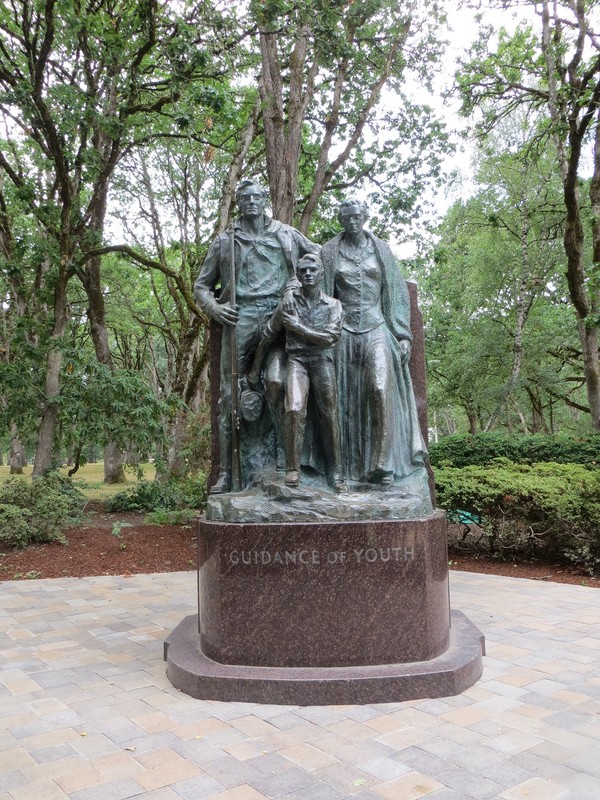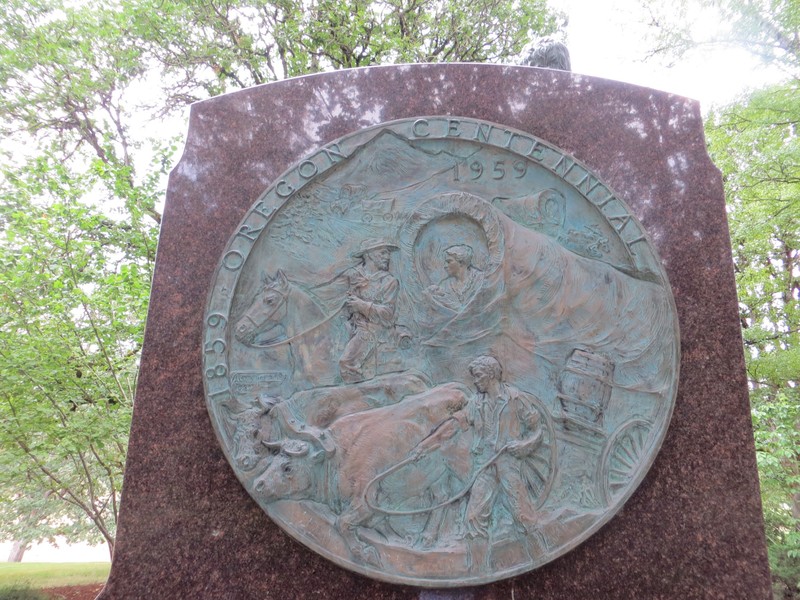Guidance of Youth statue
Introduction
Text-to-speech Audio
Images
Guidance of Youth. Photo by Cynthia Prescott.

Oregon Centennial medallion on reverse of monument. Photo by Cynthia Prescott.

Backstory and Context
Text-to-speech Audio
Upon his death in 1940, former janitor and elevator operator Caroll Moores bequeathed $25,000 from his modest estate to fund a pioneer memorial in his hometown of Salem, Oregon. Such pioneer monuments had been extremely popular in the 1920s and 1930s. But as World War II raged in Europe and the Pacific, Americans lost interest in erecting bronze and marble monuments to Pioneer Mothers.
After a decade of inactivity, individuals began to suggest uses for those funds. Most suggestions seemed to promote proposers’ pet projects: children’s playground, an ambulance, a community building, a wading pool, or a municipal golf course. A special commission named by the city favored “statuary of a highly artistic character.”1 But popular opinion appeared to strongly favor erecting a small memorial in the Odd Fellows cemetery and using the income from the remainder of the fund to maintain that cemetery because a number of prominent pioneers were buried there.
The people of Salem were understandably shocked when a plan was announced to purchase a nude 1914 Venus Victorious statue sculpted by prominent French artist Pierre-Auguste Renoir with Moores’ bequest. That statue represented a dramatic departure from traditional depictions of pioneer women in sunbonnets. The opinion page of the Salem Capital Journal filled with outraged letters from church boards, garden clubs, and individuals who believed that the impressionist nude sculpture of the Roman goddess of love did not represent Oregon pioneers, and was not appropriate to erect in front of the new county courthouse. The national media soon picked up the story.
“‘What we want,’ said one member of the Lions, is a statue of a pioneer woman in a gingham dress and a sunbonnet … not this trash.’”2
When the public was invited to comment on alternate proposals, significant public support developed for a local artist’s modernist allegory including a male nude figure representing the Spirit of the Oregon Trail. Instead, the local park commission settled on a much safer choice: a pioneer family group by longtime pioneer monument sculptor Avard T. Fairbanks, which they would erect in a local park. The Oregon Statesman columnist described Fairbanks’ design as “’safe’” and “indulg[ing] in no abstraction.”3 Fairbanks was overjoyed that his traditional pioneer imagery prevailed:
"This is a very great triumph in America because at one time there were art interests and those directing the new movements and isms who made recommendations for the erection of a nude 'Venus' by the French modernist, Renoir. Had it been completed Oregon would have had a French female nude to represent the pioneer mothers of the great Oregon Trail. What a travesty... Fortunately, we have real Westerners and true Americans who still believe that our cultural heritage is well worth memorializing with true and sincere presentations rather than by sophisticated misrepresentations."4
Tellingly, Fairbanks declared the iconic white pioneer woman to represent not only “real Westerners” whose ancestors had carried white civilization westward, but also all “true Americans,” whose identity had become inextricably linked to western mythology by the 1950s.
Earlier works by Fairbanks and his contemporaries tended to focus on self-sacrificing pioneer mothers. In contrast, Guidance of Youth placed a young man at the center of the 1950s Salem monument. In the midst of Cold War uncertainty, mainstream America’s energetic youth, rather than its mothers’ civilizing influence, represented the nation’s greatest hope for the future. But the 19th-century frontier myth still underpinned American national identity.
Cite This Entry
Prescott, Cynthia. "Guidance of Youth statue." Clio: Your Guide to History. June 20, 2019. Accessed April 22, 2025. https://theclio.com/entry/82450
Sources
1. “Council to Act on New ‘Nuisance’ Taxes,” Daily Capital Journal, December 27, 1951.
2. “Venus Observed,” Time July 6, 1953. http://www.time.com/time/magazine/article/0,9171,822851,00.html. Accessed August 11, 2009.
3. Sprague, Charles A. “It Seems to Me,” The Oregon Statesman July 5, 1959.
4. Fairbanks, Avard, to Barbara Cross, May 22, 1956. “Avard T. Fairbanks Papers.” Accession No. 1336. J. Willard Marriott Library, University of Utah, Salt Lake City, Utah. Box 4, Folder 6.

